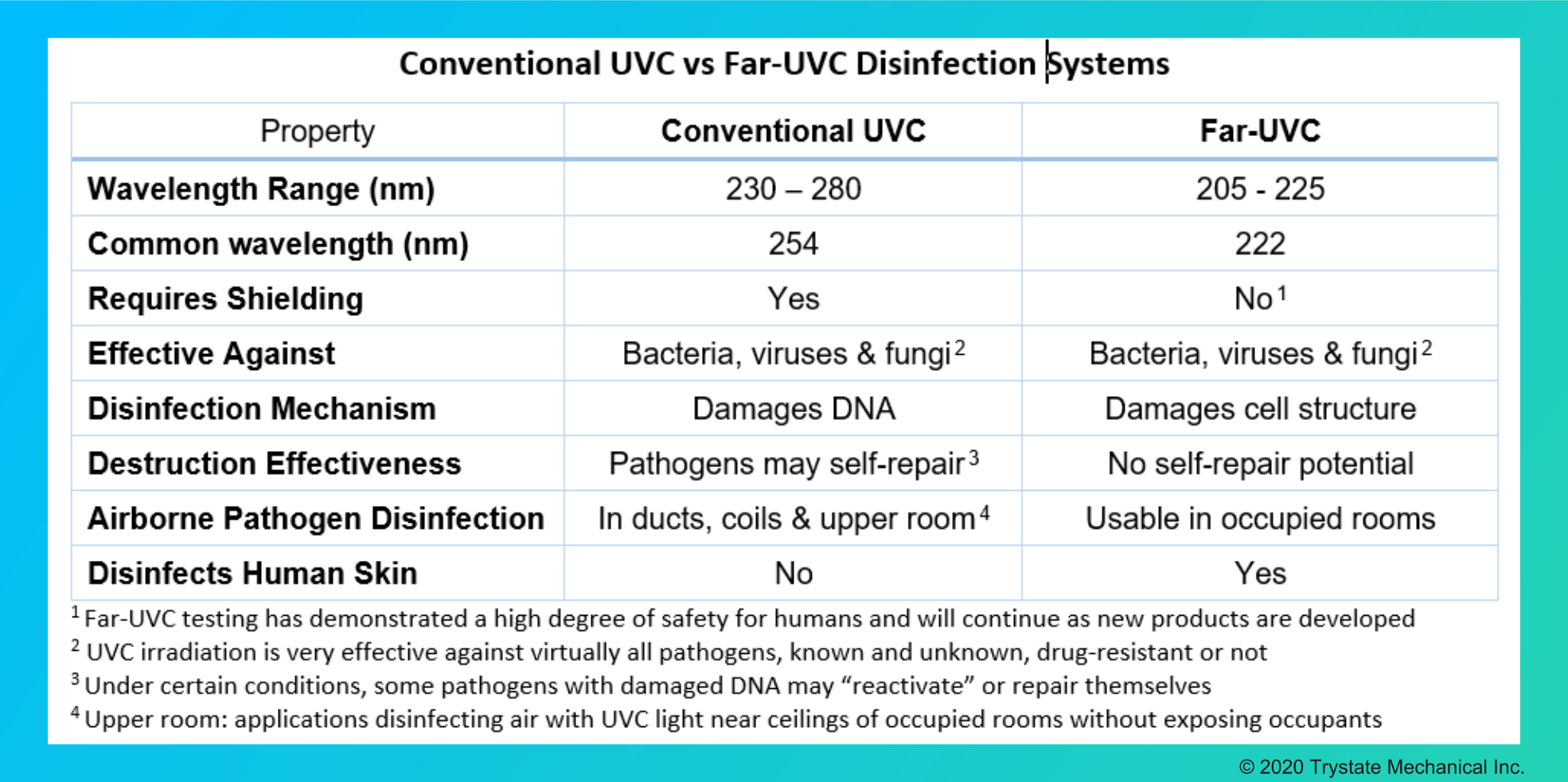Anti-Viral Lighting for Facilities
Posted on April 6th, 2020With COVID-19 ravaging the world, businesses shut down and people quarantined, we have painfully learned how vulnerable we are to infectious diseases and how communicable they can be. Once COVID-19 passes, everyone will be looking for ways to avoid the effects of the next pandemic. To this end, building and facility owners may want to consider Ultraviolet Germicidal Irradiation (UVGI) and keep an eye out for a new technology called Far-UVC. The following describes two types of non-chemical disinfection technologies capable of killing all bacteria, fungi and viruses, known and unknown, drug-resistant or not.
Ultraviolet Light
Ultraviolet light is a form of electromagnetic radiation (EMR) that physicists describe as being a spectrum of energy waves varying in wavelength and frequency. You will be familiar with many of the names that describe the different categories of EMR: radio waves, microwaves, infrared, visible light, ultraviolet light, X-rays and gamma rays. EMR has wavelengths (peak-to-peak) running from the super-long radio waves (1,000,000 meters) to gamma rays with subatomic wavelengths (0.00000000001 meters). And, while it may seem counterintuitive, the microscopic gamma ray can have energy levels a billion billion (quintillion) times higher than miles-long radio waves (10E6 electron Volts versus 10E-12 eV).
On the EMR spectrum, shorter wavelengths are measured in nanometers (nm) which are billionths of a meter (10E-9 meters). Visible light falls in the range of 400 to 700 nm, and ultraviolet light operates at 10 to 400 nm. The ultraviolet light spectrum is further broken down into subcategories. Most people recognize UVA and UVB (ultraviolet light A & B) as the part of EMR from the Sun that causes us to need sunscreen and sunglasses and that breaks down certain materials, especially plastics. Few people, however, are likely to recognize UVC.
UVC
Along with UVA and UVB, the Sun produces UVC which is almost entirely blocked from reaching the Earth by the ozone layer and atmosphere. Nothing is absolute, however, UV light is generally categorized as UVA operating between roughly 315 and 400 nm, UVB between 280 and 315 nm and UVC between 100 and 280 nm. The shorter wavelength and higher energy of UVC gives it unique germicidal properties compared to other types of light. Traditionally, Ultraviolet Germicidal Irradiation (UVGI) utilizes artificial UVC light that is very effective at killing molds, viruses, bacteria and other pathogens in air and water and on various surfaces.
UVGI is widely used throughout the food, hospitality, healthcare and pharmaceutical industries. Studies done in the first half of the 1900s suggested that UVC in the range of 250 to 285 nm provided the best disinfection results usually by inactivating organisms. Today, UVGI predominantly operates around 254 nm to disrupt the molecular DNA of viruses and bacteria. Although UVGI is very effective in rendering pathogens harmless, it is also widely recognized that under certain conditions viruses and bacteria with DNA damaged may be able to reactivate their disease-producing capabilities.
Humans are primary distributors of airborne aerosolized pathogens through sneezing, coughing and even breathing. This makes the treating of air with non-chemical 254 nm UVC light very attractive. Unfortunately, what makes UVC good at eliminating pathogens can also produce cancer and cataracts in humans. But, just a few nanometers down the UV spectrum, something called “Far-UVC” promises a very different solution.
Far-UVC

Several characteristics make Far-UVC unique as a UVGI source. First, the Far-UVC wavelength is closer to the size of bacteria and virus cells than it is to human cells and water molecules. This smaller size also enables Far-UVC to attack disease-carrying cells differently than conventional UVGI. Second, the higher energy of Far-UVC radiation helps to cause the destruction of pathogen cells in such a way that reactivation is very unlikely.
Lastly, Far-UVC radiation has been demonstrated safe for humans exposed to it. The shorter wavelength of Far-UVC cannot penetrate the non-living, outer layers of human skin nor can it reach delicate eye tissue since it is stopped by the outer tear layer.
Now, the natural question is, “Why didn’t we know about Far-UVC sooner?” Well, creating light at a single, specific wavelength requires finding a light source capable of producing that wavelength with sufficient intensity and then developing filters capable of blocking unwanted wavelengths. Researchers from Colombia University, in 2012, started looking at different UVC wavelengths that would eliminate airborne viruses yet be safe for people. They focused on the potential capabilities of Far-UVC and have since demonstrated its effectiveness against airborne H1N1 virus to be about the same as conventional UVGI but harmless to humans.
The development of commercial Far-UVC systems is in its infancy as a handful of entrepreneurs struggle to find funding, production and distribution. The COVID-19 pandemic will very likely accelerate this effort as the world no longer views pandemics in the abstract.
Future of UVGI
The future of UVC and Far-UVC germicidal irradiation will be driven by the threat of future pandemics. Well-proven conventional UVGI lamp technology will continue to be broadly used in applications such as HVAC and potable water disinfection. As technology advances, today’s gas-filled UVC UVGI lamps will gradually be replaced by more energy efficient, smaller and longer-lasting LEDs. Simultaneously, Far-UVC technology should continue to be refined, cost-reduced and to gain broader acceptance.
As important and universal a disinfection technology in the fight against disease and pandemics that UVGI may be, it isn’t the complete answer. Air flow, air change rates, dilution, negative pressure zones, filtration, temperature and humidity control are among other factors that need to be considered to control airborne and surface disease transmission.
When you have questions or concerns about the “health” status of your facilities, call on the professionals at Equans MEP Services. Since building disease mitigation measures may have a negative impact on energy consumption, EQUANS MEP Services offers a holistic building assessment to make sure that improving your building’s health doesn’t cost an arm and a leg.
